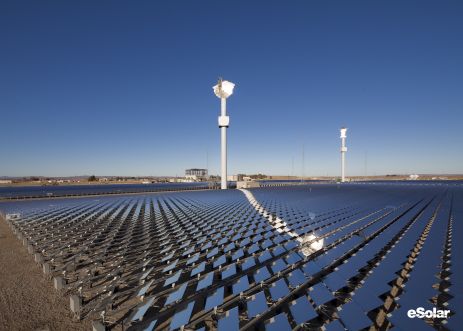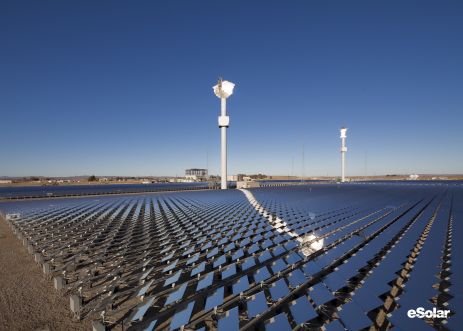Forget Red China. It’s Green China these days — at least when it comes to making big renewable deals.
 eSolar power plant. Friday night, a Chinese developer and eSolar of Pasadena, Calif., signed an agreement to build solar thermal power plants in the Mongolian desert over the next decade. These plants would generate a total of 2,000 megawatts of electricity. It’s the largest solar thermal project in the world and follows another two-gigawatt deal China struck in October with Arizona’s First Solar for a massive photovoltaic power complex. Altogether, the eSolar and First Solar projects would produce, at peak output, the amount of electricity generated by about four large nuclear power plants, lighting up millions of Chinese homes.
eSolar power plant. Friday night, a Chinese developer and eSolar of Pasadena, Calif., signed an agreement to build solar thermal power plants in the Mongolian desert over the next decade. These plants would generate a total of 2,000 megawatts of electricity. It’s the largest solar thermal project in the world and follows another two-gigawatt deal China struck in October with Arizona’s First Solar for a massive photovoltaic power complex. Altogether, the eSolar and First Solar projects would produce, at peak output, the amount of electricity generated by about four large nuclear power plants, lighting up millions of Chinese homes.
Is China the new California, the engine powering the green tech revolution?
Yes and no. When it comes to technological and entrepreneurial innovation, Beijing lags Silicon Valley (and Austin, Boston, and Los Angeles) — for now. But as a market, China is likely to drive demand for renewable energy, giving companies like eSolar the opportunity to scale up their technology and drive down costs.
[We’ll pause here to state the obvious: China’s investment in renewable energy and other green technologies is miniscule compared to the resources devoted to its continued building of coal-fired power plants and efforts to secure dirty oil shale supplies in Canada and elsewhere.]
“All the learning from this partnership will help us in the United States,” Bill Gross, eSolar’s founder and chairman, told me. “I think as soon as the economy improves in the rest of the world and banks start lending, there will be a lot of competition in the U.S. and Europe. But, until then, China has the money and the demand.”
In a one-party state, a government official saying, “Make it so,” can remove obstacles to any given project and allocate resources for its development. Construction of the first eSolar project, a 92-megawatt power plant, in a 66-square-mile energy park in northern China, is set to begin this year
“They’re moving very fast, much faster than the state and U.S. governments are moving,” says Gross, who is licensing eSolar’s technology to a Chinese firm, Penglai Electric, which will manage the construction of the power plants. Another Chinese company will open and operate the projects.
For the past two-and-a-half years in California, meanwhile, the state’s first new solar thermal power plant in two decades has been undergoing licensing as part of an extensive environmental review process. The goal is to maximize production of carbon-free electricity from BrightSource Energy’s 400-megawatt Ivanpah Solar Electric Generating System project in the Mojave Desert while minimizing its impact on fragile ecosystems.
The end game begins Monday in Sacramento at a public hearing where BrightSource will face off with environmental groups that argue the project will harm the imperiled desert tortoise and destroy the habitat for a host of plants and animals.
In contrast, it was only six months ago that executives from Penglai Electric first contacted eSolar as they scoured the world for a technology to use in that nation’s first big foray into solar thermal power.
China leads the world in production of photovolatic panels like those found on residential and commercial rooftops, but the country has had little experience with solar thermal technology, which uses arrays of mirrors called heliostats to heat a liquid to create steam that drives an electricity-generating turbine.
Penglai executives flew to Los Angeles last fall to meet with Gross and examine a five-megawatt demonstration power station called Sierra that eSolar brought online in August in the Southern California exurb of Lancaster. “A parade of people came over — we probably had 20 different government officials from China come to look at Sierra and review its operation,” said Gross.
“The most convincing aspects of eSolar’s technology is the fact that it is the only commercially operating technology in North America,” Eric Wang, a Penglai Electric spokesman, told me in an email.
That’s not quite correct — a solar trough plant was recently built in Nevada and solar power plants from the 1980s continue to operate in California — but eSolar’s technology is particularly suited for China.
As I wrote in a Green State column about eSolar last year, eSolar’s innovation is its sophisticated software controls systems and imaging technology which controls heliostats that focus the sun’s rays on a tower that contains a water-filled receiver. That allows the company to use small mirrors packed closely together as the software positions them to create a virtual parabola to focus sunlight. The mirrors are cheap to make and easy to install.
“When we do solar fields in California, we use $8 labor to open up the fields,” said Gross. “It takes 15 minutes training. In China, they wanted to use untrained labor as well.”
Since eSolar can place the mirrors close together — its standard 46-megawatt solar farm has 176,000 of them — the power plants needs half the land of an equivalent photovoltaic farm, according to Gross — a feature attractive to China, Wang said.
China, however, is not merely importing eSolar’s technology. Biomass power plants will be built alongside the solar farms and will use the same turbines, cutting the project’s costs and allowing the energy complex to operate when the sun goes down. The sand willow plant, a shrub planted in the surrounding region to fight desertification, will provide the fuel for the biomass power plants, according to Penglai Electric. ESolar already makes its heliostats in China and will begin manufacturing its proprietary receiver technology there as well.
While eSolar, which counts Google among its investors, retains ownership of the intellectual property behind its solar technology, China will gain valuable experience building and operating large-scale renewable energy facilities.
Much the same is happening in the nascent electric car industry, where China is pushing ahead and partnering with California companies like Coda Automotive to develop advanced battery technology.
All of which is not necessarily a bad thing. But one has to wonder if it won’t be too long before we’re cruising down the Pacific Coast Highway in our Chinese-made electric car and plugging it in to our Chinese-made solar array.



